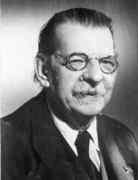Person: Châtelet, Albert

Albert Châtelet was a French politician and mathematician who researched in number theory and in algebra. He stood for the post of French president but was defeated by de Gaulle.
Mathematical Profile (Excerpt):
- Albert's early education was in Valhuon but then he studied at the Collège in St Pol sur Ternoise.
- This lycée had a long history dating back to the Jesuit College of Anchin but when Châtelet studied there the lycée had been remodelled following the 1848 revolution.
- After taking the entrance examinations of the École Polytechnique and the École Normale Supérieure, Châtelet entered the École Normale Supérieure in 1905, considered the better of the two for mathematics at that time.
- Châtelet was in charge of a course at the Collège de France in 1912.
- In 1913 Châtelet was appointed as a lecturer at the Faculty of Science at Toulouse.
- Châtelet, called to the lectureship in Lille on 5 August, was drafted into the army medical corps.
- As a result of Charbonnier's memo, a dozen mathematicians, physicists and astronomers would join the Gâvre Commission over the course of the war, including Albert Châtelet (1883-1960), Georges Valiron (1884-1955), Joseph Kampé de Fériet (1893-1982), and Arnaud Denjoy (1884-1974).
- Châtelet was one of a dozen mathematicians and physicists who worked there under military guidance.
- Châtelet undertook this work until September 1917.
- In a talk delivered in Lille in 1924, Châtelet recalled an accident that occurred to him.
- Châtelet was appointed to fill this chair in 1920 but soon another vacancy occurred when Charles Albert Petot (1851-1927), the professor of rational mechanics, retired.
- Again Châtelet was chosen to fill the chair.
- Châtelet was elected by his colleagues to the role in October of that year.
- However, when he retired in 1924 there was still much to do to bring the university back to a top level institution and Châtelet launched himself into this task with great enthusiasm.
- In January 1937, Châtelet left Lille when he was appointed by Jean Zay, the Minister of National Education and Fine Arts in the French government, to be Director of Secondary Education.
- During his three years as Director of Secondary Education, Châtelet had been involved in producing a major package of educational reforms.
- However, once the Germans had set up the Vichy government in France, Châtelet and his reforms were totally out of favour and he had to leave the Department of Education.
- Châtelet returned to university teaching, being appointed as a professor in the Faculty of Sciences in Caen in March 1941.
- Châtelet displayed the same skills as an administrator in his role as Dean of the Faculty of Science as he had during his time as rector of the University of Lille.
- Châtelet organised a number of conferences attempting to solve the Algerian problem while fighting there intensified with increasing numbers of French troops being sent to put down the rebellion.
- Châtelet strongly opposed de Gaulle's return, as did François Mitterrand and Pierre Mendes-France.
- Politicians on the left, including François Mitterrand and Pierre Mendes-France, chose Châtelet to be the left-wing candidate to oppose de Gaulle in this election.
- It resulted in a victory for de Gaulle with Châtelet gaining only about 8% of the vote.
- We have not said much about Châtelet's research in number theory and in algebra.
- Châtelet published the three-volume work Arithmétique et algèbre modernes Ⓣ(Arithmetic and modern algebra) (1954, 1956, 1966) containing over 1000 pages in total.
- Châtelet was honoured with being made an Officer of the Légion d'Honneur on 10 February 1955 and Commander of the Academic Palms on 2 July 1956.
- François Châtelet began his mathematical career as an assistant at Lille, Jean Châtelet was headmaster at a school in Arras before becoming Inspector General, while Albert Châtelet became the youngest curator of the Museum of Fine Arts in Lille.
- François Châtelet (1912-1987) went on to become a professor at the University of Besançon.
Born 24 October 1883, Valhuon, Pas-de-Calais, France. Died 30 June 1960, Paris, France.
View full biography at MacTutor
Thank you to the contributors under CC BY-SA 4.0! 

- Github:
-

- non-Github:
- @J-J-O'Connor
- @E-F-Robertson
References
Adapted from other CC BY-SA 4.0 Sources:
- O’Connor, John J; Robertson, Edmund F: MacTutor History of Mathematics Archive
